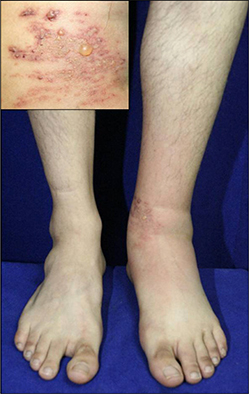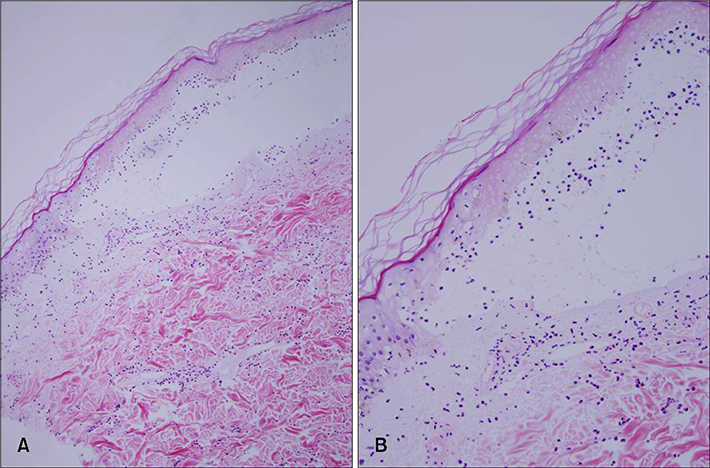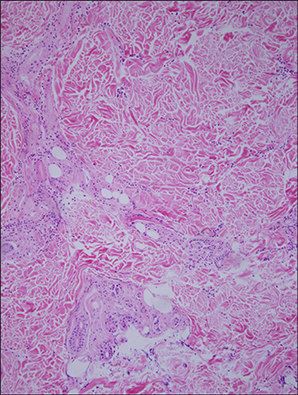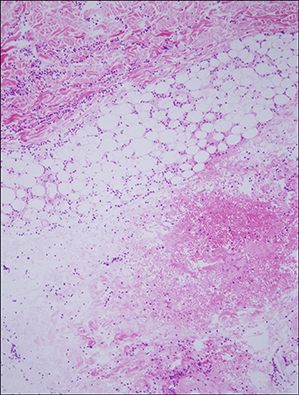Ann Dermatol.
2008 Dec;20(4):212-215. 10.5021/ad.2008.20.4.212.
A Case of Cellulitis Associated with Coral Injury
- Affiliations
-
- 1Department of Dermatology, Gil Medical Center, Gachon University of Medicine and Science, Incheon, Korea. dmjj1@gilhospital.com
- KMID: 2156397
- DOI: http://doi.org/10.5021/ad.2008.20.4.212
Abstract
- Corals are the marine organism that belongs to the phylum Cnidaria, and are one of the common causes of superficial injury in the marine environment. In addition to acute reactions such as burning or stinging pain and erythema, coral injuries may present with complications such as foreign body reactions, bacterial infections, and/or localized eczematous reactions. A 23-year-old male presented with an erythematous edematous tender patch with centrally grouped vesicles on the left ankle; the injury had occurred during skin-scuba diving 2 days before. A biopsy of the lesion treated with hematoxylin-eosin stain showed epidermal necrosis with subepidermal blisters and neutrophilic panniculitis. Herein we report a case of cellulitis caused by the nematocyst stings of corals.
Keyword
MeSH Terms
Figure
Cited by 1 articles
-
Serum Procalcitonin Level Reflects the Severity of Cellulitis
Soo Hyeon Noh, Seok Don Park, Eun Jung Kim
Ann Dermatol. 2016;28(6):704-710. doi: 10.5021/ad.2016.28.6.704.
Reference
-
1. Scharf MJ, Daly JS. Bites and stings of terrestrial and aquatic life. In : Freedberg IM, Eisen AZ, Wolff K, Austen KF, Goldsmith LA, Katz SI, editors. Fitzpatrick's dermatology in general medicine. 6th ed. New York: McGraw-Hill;2003. p. 2270–2271.2. Burke WA. Cnidarians and human skin. Dermatol Ther. 2002; 15:18–25.
Article3. Zoltan TB, Taylor KS, Achar SA. Health issues for surfers. Am Fam Physician. 2005; 71:2313–2317.4. Auerbach PS, Burgess GH. Injuries from nonvenomous aquatic animals. In : Auerbach PS, editor. Wilderness medicine [Internet]. 5th ed. Philadelphia: Mosby Elsevier;2007. cited 2008 May 2. Available from: http://www.mdconsult.com/das/book/body/93629417-2/0/1483/692.html?tocnode=54238530&fromURL=692.html#4-u1.0-B978-0-323-03228-5..50077-X--cesec56_4329.5. Habif TP. Dermatitis associated with swimming. In : Habif TP, editor. Clinical dermatology: a color guide to diagnosis and therapy. 4th ed. Chile: Mosby;2004. p. 539–543.6. Miracco C, Lalinga AV, Sbano P, Rubegni P, Romano C. Delayed skin reaction to Red Sea coral injury showing superficial granulomas and atypical CD30+ lymphocytes: report of a case. Br J Der matol. 2001; 145:849–851.
Article7. Addy JH. Red sea coral contact dermatitis. Int J Dermatol. 1991; 30:271–273.
Article8. Dagregorio G, Guillet G. Delayed dermal hypersensitivity reaction to coral. J Am Acad Dermatol. 2005; 52:534–535.
Article





